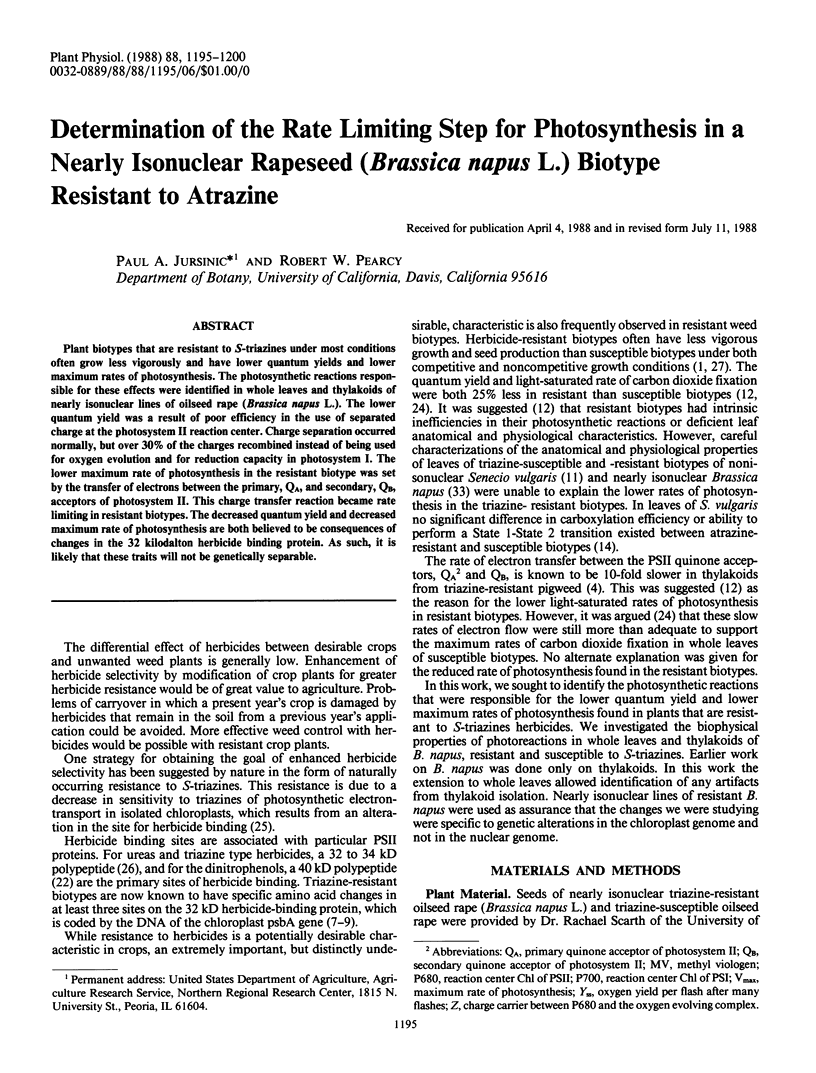Abstract
Plant biotypes that are resistant to S-triazines under most conditions often grow less vigorously and have lower quantum yields and lower maximum rates of photosynthesis. The photosynthetic reactions responsible for these effects were identified in whole leaves and thylakoids of nearly isonuclear lines of oilseed rape (Brassica napus L.). The lower quantum yield was a result of poor efficiency in the use of separated charge at the photosystem II reaction center. Charge separation occurred normally, but over 30% of the charges recombined instead of being used for oxygen evolution and for reduction capacity in photosystem I. The lower maximum rate of photosynthesis in the resistant biotype was set by the transfer of electrons between the primary, QA, and secondary, QB, acceptors of photosystem II. This charge transfer reaction became rate limiting in resistant biotypes. The decreased quantum yield and decreased maximum rate of photosynthesis are both believed to be consequences of changes in the 32 kilodalton herbicide binding protein. As such, it is likely that these traits will not be genetically separable.
Full text
PDF





Selected References
These references are in PubMed. This may not be the complete list of references from this article.
- Bowes J., Crofts A. R., Arntzen C. J. Redox Reactions on the reducing side of photosystem II in chloroplasts with altered herbicide binding properties. Arch Biochem Biophys. 1980 Apr 1;200(2):303–308. doi: 10.1016/0003-9861(80)90359-8. [DOI] [PubMed] [Google Scholar]
- Ehleringer J., Björkman O. Quantum Yields for CO(2) Uptake in C(3) and C(4) Plants: Dependence on Temperature, CO(2), and O(2) Concentration. Plant Physiol. 1977 Jan;59(1):86–90. doi: 10.1104/pp.59.1.86. [DOI] [PMC free article] [PubMed] [Google Scholar]
- Erickson J. M., Rahire M., Bennoun P., Delepelaire P., Diner B., Rochaix J. D. Herbicide resistance in Chlamydomonas reinhardtii results from a mutation in the chloroplast gene for the 32-kilodalton protein of photosystem II. Proc Natl Acad Sci U S A. 1984 Jun;81(12):3617–3621. doi: 10.1073/pnas.81.12.3617. [DOI] [PMC free article] [PubMed] [Google Scholar]
- Erickson J. M., Rahire M., Rochaix J. D., Mets L. Herbicide resistance and cross-resistance: changes at three distinct sites in the herbicide-binding protein. Science. 1985 Apr 12;228(4696):204–207. doi: 10.1126/science.228.4696.204. [DOI] [PubMed] [Google Scholar]
- Hirschberg J., McIntosh L. Molecular Basis of Herbicide Resistance in Amaranthus hybridus. Science. 1983 Dec 23;222(4630):1346–1349. doi: 10.1126/science.222.4630.1346. [DOI] [PubMed] [Google Scholar]
- Holt J. S., Goffner D. P. Altered Leaf Structure and Function in Triazine-Resistant Common Groundsel (Senecio vulgaris). Plant Physiol. 1985 Nov;79(3):699–705. doi: 10.1104/pp.79.3.699. [DOI] [PMC free article] [PubMed] [Google Scholar]
- Holt J. S., Stemler A. J., Radosevich S. R. Differential Light Responses of Photosynthesis by Triazine-resistant and Triazine-susceptible Senecio vulgaris Biotypes. Plant Physiol. 1981 Apr;67(4):744–748. doi: 10.1104/pp.67.4.744. [DOI] [PMC free article] [PubMed] [Google Scholar]
- Jursinic P., Stemler A. Changes in [C]Atrazine Binding Associated with the Oxidation-Reduction State of the Secondary Quinone Acceptor of Photosystem II. Plant Physiol. 1983 Nov;73(3):703–708. doi: 10.1104/pp.73.3.703. [DOI] [PMC free article] [PubMed] [Google Scholar]
- Jursinic P., Warden J., Govindjee A major site of bicarbonate effect in system II reaction. Evidence from ESR signal IIvf, fast fluorescence yield changes and delayed light emission. Biochim Biophys Acta. 1976 Aug 13;440(2):322–330. doi: 10.1016/0005-2728(76)90066-9. [DOI] [PubMed] [Google Scholar]
- Kok B., Forbush B., McGloin M. Cooperation of charges in photosynthetic O2 evolution-I. A linear four step mechanism. Photochem Photobiol. 1970 Jun;11(6):457–475. doi: 10.1111/j.1751-1097.1970.tb06017.x. [DOI] [PubMed] [Google Scholar]
- Mauzerall D. Light-induced fluorescence changes in Chlorella, and the primary photoreactions for the production of oxygen. Proc Natl Acad Sci U S A. 1972 Jun;69(6):1358–1362. doi: 10.1073/pnas.69.6.1358. [DOI] [PMC free article] [PubMed] [Google Scholar]
- Ort D. R., Ahrens W. H., Martin B., Stoller E. W. Comparison of Photosynthetic Performance in Triazine-Resistant and Susceptible Biotypes of Amaranthus hybridus. Plant Physiol. 1983 Aug;72(4):925–930. doi: 10.1104/pp.72.4.925. [DOI] [PMC free article] [PubMed] [Google Scholar]
- Pfister K., Radosevich S. R., Arntzen C. J. Modification of Herbicide Binding to Photosystem II in Two Biotypes of Senecio vulgaris L. Plant Physiol. 1979 Dec;64(6):995–999. doi: 10.1104/pp.64.6.995. [DOI] [PMC free article] [PubMed] [Google Scholar]
- Pfister K., Steinback K. E., Gardner G., Arntzen C. J. Photoaffinity labeling of an herbicide receptor protein in chloroplast membranes. Proc Natl Acad Sci U S A. 1981 Feb;78(2):981–985. doi: 10.1073/pnas.78.2.981. [DOI] [PMC free article] [PubMed] [Google Scholar]
- Schönfeld M., Yaacoby T., Michael O., Rubin B. Triazine Resistance without Reduced Vigor in Phalaris paradoxa. Plant Physiol. 1987 Feb;83(2):329–333. doi: 10.1104/pp.83.2.329. [DOI] [PMC free article] [PubMed] [Google Scholar]
- Vaughn K. C. Characterization of Triazine-Resistant and -Susceptible Isolines of Canola (Brassica napus L.). Plant Physiol. 1986 Nov;82(3):859–863. doi: 10.1104/pp.82.3.859. [DOI] [PMC free article] [PubMed] [Google Scholar]


